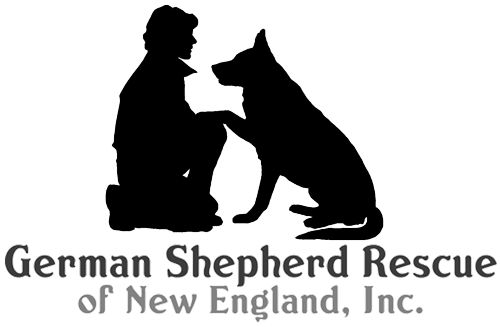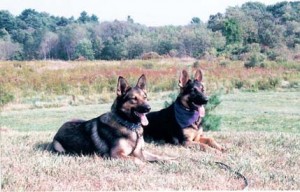No Results Found
The posts you requested could not be found. Try changing your module settings or create some new posts.
#094 Maggie
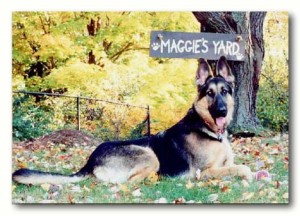
#107 Zoe

She goes out walking with me for an hour every morning, getting a chance to interact with other dogs at the dog park, and walks with Chris every afternoon. She continually evolves and is a much less timid dog. We love her and are so glad we have her.
Zoe has certainly found her niche in ours lives-a pretty big one, it is.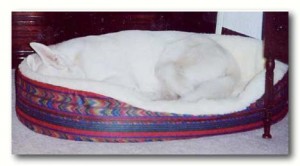
#120 Minka
When my husband and I first contacted Janice Ritter, we told her we were interested in fostering and that we had a one year old male GSD at home and thought a companion would be nice. Janice immediately said she had a female dog in mind. We signed our paperwork September 9, 2001 and welcomed our new member of our family.
Although it was not love at first sight, Minka turned
They say Minka is in her Golden Years, but she still can move! She still tries to chase the deer in back of our house and goes on adventures looking for wildlife. These days Minka likes to take it easy and be pampered, maybe that comes with age! She still looks beautiful and has no medical problems. I thank Janice for bringing the perfect dog into our lives, and for all the volunteers that work so hard for this wonderful breed.
Minka is a great dog; she has adapted very well to her new life and family. Minka starts her day at the beach, then back to the house where she can play freely with her brother Blaze, our male shepherd, who is the same age. Minka plays with all the children in the neighborhood, she has participated in walks for the MSPCA and enjoys following the deer tracks in our back yard. We are so happy Janice told us about her and got her out of the shelter. I can’t believe someone did not want her. Too bad for them!
Sincerely,
Eric & Sandra Shoemaker
#000 Sport
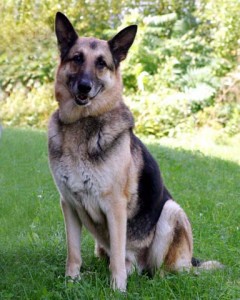
I wanted to send you a story about Sport. I believe you originally had him in Wayland before he was sent to the Blue Dog Shelter in Brockton. His picture is still on your website. I adopted Sport Christmas week of 2003. He was such a great companion not only to me but to my other dog Mittens. Sadly he was diagnosed with lymphoma in November 2004. He went through 4 months of chemo at NEVOG in Waltham under the care of a wonderful vet, Dr. Kim Cronin. Just when he was finished with chemo treatments in April he become weak and was diagnosed with hermangiosarcoma, a cancer of the pericardium of the heart.
I don’t want this to be a sad tale about Sport but rather a tale of how he was loved to the end. I had the joy of making him part of my family and in that short time I had him he was awesome. I am including a picture of Sport and his sister Mittens on the deck in happier times. Keep up the good work.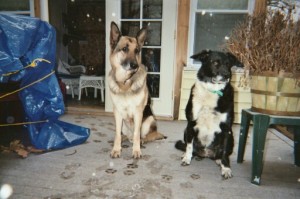
#090 Sheba

Sheba was placed into a special foster home that was used to dealing with behavioral problems and issues. In time, using love and tenderness, Sheba learned about rules and how to “win”. She was able to romp with other dogs and take her time learning about humans.
Sheba now lives in a wonderful home where she is doted on. She is obedience trained and loves her cat friends. She will never have to suffer again.
Update:
Sheba and I celebrated our tenth anniversary together in 2010, and it’s truly been a “happy tail.” Others had written her off as not savable, but GSRNE did their miracles and turned Sheba’s life around.
In December 1999, she was found on the street in Massachusetts–young, very frightened, and badly abused. Her paws were covered with blood, and her face, according to the Animal Control Officer, “looked like raw hamburger meat.” The pound had no funds to treat her for her injuries. Another rescue stepped in and had Sheba (as the ACO named her) transferred to the vet. The vet thought she might be an escapee from a backyard breeder who kept her dogs locked in rabbit cages. Sheba was clearly unsocialized with people. She recovered quickly physically, but her behavior issues meant she could not be placed. People frightened her, and any change in her environment paralyzed her with fear.
GSRNE stepped in and found a foster home willing to take on a “project dog” (a dog that requires a lot of work to be adoptable). I adopted her a few months later in July 2000. I had years of German Shepherd experience, but Sheba demanded new skills and tremendous patience. I had to learn an entirely new body language. Using Turid Rugaas’ “Calming Signals,” I was gradually able to rehabilitate Sheba. A quiet life here in Vermont was just what she needed.
People who see her today would never believe how she started out. Sheba is now the calm, stable dog in the pack. She holds office hours with me on campus, and the students love her. She visits the nursing home where my mother lives, and has her own fan club there. She’s always been a dream in the house, and gets along great with the cats who have shared her space.
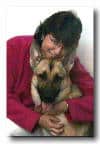
Sheba is one of the most affectionate GSDs I’ve seen. Right from the start, when everything else scared her, the bed was a safe place. She would jump up beside me and bury her nose under my arm. We start every morning with “bed cuddles” and spooning. I’m lucky enough to work at home about half time, and she’s always by my side. Every day we walk in the woods, off leash on my twenty acres, and Sheba gets to swim in rivers and splash in the beaver pond next door. She’s a happy, happy girl.
I’ve been blessed to have Sheba in my life, and I’ll always be grateful to GSRNE for giving her the chance that brought her to me.
Reina Pennington
#093 Tai Bo
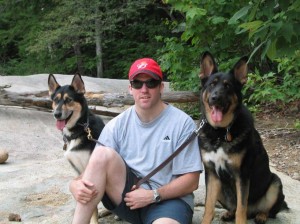
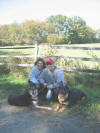

#150 Bailey

GSRNE worked with Bailey for a very, very long time. Eventually, we were able to build in other coping mechanisms as well as teaching Bailey to trust. In time, she learned to get along with some other dogs and play nicely with the cats in foster care.
Bailey now lives with a family of her own. She is loved and cared for and doesn’t have to worry about sitting at the end of a short chain anymore.
#102 Kelly
Kelly GSRNE #102
Kelly was purchased by her previous owner as a puppy and then tied outside for 3 years. The owner bred her, then left her to have her puppies outside, alone in the winter elements. The puppies all died of exposure. Eight weeks later, the owner dumped Kelly at a shelter and told them to have her put to sleep. The shelter workers walked her down the hall to have her PTS but she was such a happy girl that wagged her tail and gave everyone kisses that they just couldn’t euthanize her, so they called GSRNE. Kelly was loaded with whip worms, had a urinary tract infection, a uterine infection, a rotten tooth, frost bitten ears and to top it all off after she got into foster care, we found she had severe hip dysplasia in both hips. GSRNE’s Abby’s “Leg”acy Fund helped to pay for Kelly’s surgery.
GSRNE was happy to be able to help this lovely girl to heal and after spending 6 months helping her through recovery we decided she was already home. Besides loving parents, Kelly lives with a number of other dogs to keep her company.
Because GSRNE fixed both of her hips, Kelly is able to run and take part in her favorite activity…chasing one of her balls! When she is done, she is happy to find a nice soft blanket, with a pillow please, to lay down on. Kelly has been a foster sister to many, many of GSRNE’s adoptive dogs. She teaches them manners and shares her blankets, toys and home with them until they can find one of their own.
Screening Applicants As Potential Homes
Step 1. Interviewing Callers.
“First come, first served” does not apply here. You are under no obligation to give your dog to the first person who says he wants him or her. You have every right to ask questions and choose the person you think will make the best new owner. Don’t let anyone rush you or intimidate you.
To help you along, the following are questions that rescuers ask potential applicants. You can print copies of this page to use as a guide when you speak to people who contact you about your dog. Get out the list you made with your requirements for a new home and compare it to the answers the applicants give.
1. Get the applicant’s name, address and phone number. Deceitful people may call you from a disguised number or give you a fake address. Ask for information you can verify.
2. Does the applicant’s family know about and approve of their plans to get a German Shepherd? If not, suggest they talk it over with their spouse and call you back. The same applies to people living with a companion or roommate. When one person adopts a dog without the full approval of the rest of the family, the adoption often fails.
3. Do they own or rent their home? If renting, does their landlord approve? You’d be surprised how many people haven’t checked with their landlord before contacting you. If you have doubts, ask for the landlord’s name and number, then call him yourself. Be cautious about renters – they’re quicker to move than people who own their homes and movers often leave their pets behind. Remember, you’re looking for a permanent home for your dog.
4. Does the caller have children? How many? How old are they? If your dog isn’t good with kids, say so up front. How many children can make a difference depending on your dog’s personality. A shy dog may not be able to cope with several children and their friends. Very young children may not be old enough to treat the dog properly. If the applicant doesn’t have children, ask if they’re thinking of having any in the near future. Many people get rid of their dogs when they start a family.
5. Have they had dogs, especially German Shepherds, before? If yes, how long did they keep them? How they treated the pets they’ve had in the past will tell you how they might treat your dog. The following answers should raise a red flag and make you suspicious:
“We gave him away when we moved.” Unless they had to because of unavoidable problems, moving is a poor excuse for giving up a pet. Almost everyone can find a place that will allow dogs if they try hard enough. If they gave up their last dog that easily, there’s a good chance they’ll give yours up someday, too. “We gave him away because he had behavior problems.” Most behavior problems poor housebreaking, chewing, barking, digging, running away – result from a lack of training and attention. If the applicant wasn’t willing to solve the problems he had with his last dog, he probably won’t try very hard with your dog either. “Oh, we’ve had lots of dogs!” Watch out for people who’ve had several different dogs in just a few years’ time. They have never kept any of them for very long.
6. Do they have pets now? What kinds? If your dog isn’t good with cats or other animals and your applicant has them, the adoption’s not going to work out. Be up front. Better to turn people away now than have to take the dog back later. The sex of their other dogs is an important consideration too. For German Shepherds, dog-aggression issues can arise in both male and female dogs. Dog fights can be serious problems and one dog can hurt or even kill the other.
7. Do they have a yard? Is it fenced? How high is the fence? Your dog will need daily exercise. Without a yard, how will he get it? Can the applicant provide it with regular walks? If the yard isn’t fenced, ask how he plans to keep the dog from leaving his property? Did the applicant’s last dog wander off or get hit by a car? If so, how will he keep this from happening to his next dog? Does he understand that our adventurous German Shepherds may wander off if left unsupervised? Does he know that keeping a German Shepherd tied up can have a bad effect on the dog’s temperament?
8. Where will the dog spend most of its time? Although most German Shepherds don’t mind spending time outside unless it’s too hot or too cold, a whole life outdoors probably isn’t what you have in mind for your dog. Dogs always kept outside are sometimes neglected, lonely and may develop behavior problems.
9. Why is the caller interested in a German Shepherd? Find out what kind of dog “personality” they’re looking for. Many people are attracted by the German Shepherd’s beauty but don’t know anything else about them. They might not have the slightest idea what a German Shepherd is all about and might not like its temperament and characteristics. If their expectations don’t match your dog’s disposition, the adoption’s not going to work. Be honest about our breed’s good and bad points. Is a German Shepherd really what they’re looking for or would they do better with another breed?
10. Ask for references: Get the phone number of their vet (if they have had pets before) and ask them to let the vet know that you will be calling. Also ask for three personal references. Call those references. Explain that the person is interested in adopting your dog and you want to know about how they are with animals. For the vet, ask if their animals had annual vaccinations and took heartworm preventative. Ask how long have they known this person? If they were placing a pet, would they feel comfortable giving it to this person? If they have owned a pet before, call animal control in their town and inquire whether there have been any complaints about their dogs. If they have had to pay fines for “dog at large”, do not adopt your dog to them.
Step 2: The In-Person Interview
Once you’ve chosen a family (or families) that you feel are good candidates, make an appointment for them to meet the dog, and another one for you to see their home. Going to their house lets you see whether their home and yard are truly what they said they are and whether your dog will do well there. It also gives you an opportunity to call off the adoption and take the dog back home with you if things aren’t as represented, if you think there’ll be problems or if you just get a bad feeling about the whole thing.
If they already have a dog, make plans to introduce the dogs on “neutral” territory, like a park. Most dogs resent meeting a strange dog at home. They may be hostile toward the new dog or even start a fight. It is best to first introduce two dogs through a chain link fence where they will be off leash and can’t harm each other. In this situation, they can act naturally as if they were in the wild.
If the family has children, ask them to bring them to the interview. You need to see how the dog will react to them and how the children treat the dog. Some allowance should be made for kids’ natural enthusiasm but if these children are undisciplined, disrespectful to your dog and not kept in hand by their parents, your dog could be mistreated in its new home and someone could get bitten.
Do you like these people? Are you comfortable having them as guests in your home? Would they make good friends? If not, don’t give them your dog. Trust your instincts. If something about them doesn’t seem quite right, even if you can’t explain what it is, don’t take a chance on your dog’s future. Wait for another family!
On a final note: Ask the potential adopters if you can visit with your dog on occasion. If they say “no”, be very leery and reevaluate this person’s potential for being a good owner.
Step 3. Saying Good-bye
After the interviews are over, give the new family a day or two to decide if they really want to adopt your dog. Make sure they have a chance to think over the commitment they’re making. While they’re deciding, get a package ready to send along with your dog. This package should include:
- Your dog’s medical records and the name, address & phone number of your vet.
- Your name, address & phone (new address if you’re moving)
- Your dog’s toys and belongings (dog bed, blanket, etc.), a supply of dog food & special treats he loves
- An instruction sheet on feeding, special needs, etc.; some reading material about the German Shepherd breed.
- Collar and leash;
- ID and rabies tags.
Set aside a special time for you and your dog to take a last walk together and say good-bye. This may be an emotional time for you but try not to show emotion in front of your dog. He may be confused about being left with strangers and you won’t want your emotions to upset him even more.
There are some things you need to explain to the new family before they take your dog home: The dog will go through an adjustment period as he gets to know his new people, learns new rules and mourns the loss of his old family. Most dogs adjust within a few days, but others may take longer. During this time, they should avoid forcing the dog to do anything stressful – taking a bath, obedience training classes, meeting too many strangers at once, etc. – until he’s had a chance to settle in. Tell them take things easy at first and give the dog time to bond to them. The dog might not eat for the first day or two. Not to worry – he’ll eat when he’s ready. Some dogs temporarily forget their training. A well-housebroken dog may have an accident during the first day in his new home. This isn’t unusual and rarely happens more than once.
Step 4. Paperwork
Have the new owner sign an adoption contract with a waiver of liability. Keep a copy for your records. A contract will help to protect the dog and the waiver of liability helps to protect you. You don’t have a crystal ball to predict what your dog might do in the future. Remember – a waiver of liability will likely not protect you if you have lied or misrepresented the dog to his new owners.
Tell the family they should call you if the adoption doesn’t work out. Let them know you want to keep in touch and will call them in a few days to see how things are going. Tell them to call you if they have questions or problems. Be willing to take the dog back home if things don’t work out the way you both expected.
If you still want to go along with the adoption and find a new home for you dog, please take the time to carefully read the following guidelines:
Where to Start – Tips for Adoption
Do You Really Have To Re-home Your Dog?
The Reality of German Shepherd Adoption
Used with permission. Adapted by German Shepherd Rescue and Adoptions, Inc from “When You Can’t Keep Your Chow Chow” written by Karen Privitello, Lisa Hrico & Barbara Malone, Chow Chow Welfare League of NPD, Inc. Reproduction other than for personal home use is prohibited without permission of the Chow Chow Club, Inc.’s Welfare Committee. For additional copies or permission to reprint, contact: The Chow Chow Club Inc.’s Welfare Committee 9828 E. County A Janesville, WI 53546 Chow Chow Welfare Hotline 608-756-2008
